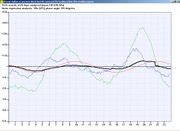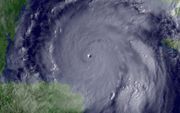How Many Atmospheres of Pressure Can a Human Survive

diurnal (daily) rhythm of air pressure in northern Germany (black curve is air pressure)
Atmospheric pressure is the pressure above any area in the Earth's temper caused past the weight of air. Standard atmospheric pressure level (atm) is discussed in the relevant section.
Contents
- 1 Effects on air
- 2 Standard atmospheric pressure
- 3 Measurement
- 3.1 Mean sea level pressure (MSLP or QFF)
- 3.2 In U.s.
- three.3 In aviation
- 4 Full general
- v Atmospheric force per unit area variation
- 6 Intuitive feeling for atmospheric force per unit area based on height of water
- 7 Meet also
- 8 References
- 9 External links
Effects on air [ ]
Air masses are afflicted by the full general atmospheric pressure inside the mass, creating areas of loftier pressure (anti-cyclones) and low pressure (depressions).
As summit increases, fewer air molecules are above. Therefore, atmospheric pressure level decreases with increasing altitude. The following relationship is a first-order approximation:
http://upload.wikimedia.org/math/5/9/4/5947a290b4faffdd30f576dd60f53366.png
where P is the pressure level in pascals and h the height in metres. This shows that the pressure at an distance of 31 km is about 10(5-ii) Pa = 1000 Pa, or 1% of that at sea level1.
A column of air, 1 square inch in cantankerous section, measured from body of water level to the superlative of the atmosphere would weigh approximately 14.seven lb. A 1 mii column of air would counterbalance about 100 kilonewtons. Meet density of air.
Standard atmospheric pressure [ ]
Standard atmospheric force per unit area or "the standard temper" (1 atm) is divers equally 101.325 kilopascals (kPa). This definition is used for pneumatic fluid power (ISO R554), and in the aerospace (ISO 2533) and petroleum (ISO 5024) industries.
In 1985, IUPAC recommended that standard atmospheric force per unit area should be 100 000 Pa = ane bar = 750 Torr. The same definition is used in the compressor and the pneumatic tool industries (ISO 2787). [i] (encounter also Standard temperature and pressure level)
This can also be stated as:
- 29 117/127 inches of mercury ≈ 29.92 inHg
- 1013.25 millibars (mbar, also mb) or hectopascals (hPa)
- 14.696 psia or 0 psig (pounds-strength per square inch, absolute or gauge) (lbf/in²)
- 2116.2 pounds-force per square human foot (lbf/ft²)
- 1 6517/196133 technical atmospheres (at) ≈ 1.03322745 at
Measurement [ ]
This "standard pressure level" is a purely arbitrary representative value for pressure at ocean level, and existent atmospheric pressures vary from identify to identify and moment to moment everywhere in the globe.
Mean sea level force per unit area (MSLP or QFF) [ ]
Mean sea level pressure (MSLP or QFF) is the pressure at bounding main level or (when measured at a given elevation on land) the station pressure reduced to sea level bold an isothermal layer at the station temperature.
This is the force per unit area ordinarily given in weather reports on radio, television, and newspapers. When barometers in the home are set up to match the local weather reports, they measure force per unit area reduced to sea level, not the bodily local atmospheric pressure level.
The reduction to sea level means that the normal range of fluctuations in pressure is the same for everyone. The pressures which are considered high pressure or depression pressure exercise non depend on geographical location. This makes isobars on a weather condition map meaningful and useful tools.
In United states of america [ ]
In the United States, compressed air flow is frequently measured in "standard cubic anxiety" per unit of measurement of time, where the "standard" means the equivalent quantity of air at standard temperature and pressure. However, this standard atmosphere is defined slightly differently: temperature = 68 °F (xx °C), air density = 0.075 lb/ft³ (i.xx kg/k³), altitude = sea level, and relative humidity = 0%. In the air-conditioning industry, the standard is often temperature = 32 °F (0 °C) instead. For natural gas, the petroleum industry uses a standard temperature of sixty °F (fifteen.6 °C).
In aviation [ ]
The altimeter setting in aviation, set either QNH or QFE, is another atmospheric pressure level reduced to ocean level, only the method of making this reduction differs slightly. Come across altimeter.
- QNH barometric altimeter setting which will crusade the altimeter to read airfield elevation when on the airfield. In ISA temperature atmospheric condition the altimeter will read altitude above mean bounding main level in the vicinity of the airfield
- QFE barometric altimeter setting which will cause an altimeter to read nix when at the reference datum of a particular airfield (by and large a track threshold). In ISA temperature atmospheric condition the altimeter will read summit above the datum in the vicinity of the airfield.
General [ ]
Average body of water-level pressure is 1013.25 hPa (mbar) or 29.921 inches of mercury (inHg). In aviation atmospheric condition reports (METAR), QNH is transmitted around the world in millibars or hectopascals, except in the United States and Canada where it is reported in inches (or hundredths of inches) of mercury. (The The states also reports sea level pressure SLP, which is reduced to sea level by a dissimilar method, in the remarks section, not an internationally transmitted part of the code, in hectopascals or millibars. In Canada's public weather condition reports, sea level force per unit area is reported in kilopascals, while Environs Canada's standard unit of pressure is hectopascal.) In the weather code, three digits are all that is needed, Decimal points and the one or two about significant digits are omitted: 1013.2 mbar or 101.32 kPa is transmitted equally 132; 1000.0 mbar or 100.00 kPa is transmitted as 000; 998.7 mbar or 99.87 kPa is transmitted every bit 987; etc. The highest bounding main-level pressure on Earth occurs in Siberia, where the Siberian High often attains a ocean-level force per unit area above 1032.0 mbar. The everyman measurable sea-level force per unit area is found at the centers of hurricanes (typhoons, baguios).
Atmospheric pressure variation [ ]

Hurricane Wilma on 19 October 2005 – 88.2 kPa in eye
Atmospheric force per unit area varies widely on the Earth, and these variations are of import in studying weather and climate. Come across pressure arrangement for the effects of air pressure variations on weather..
Intuitive feeling for atmospheric pressure based on elevation of water [ ]
Atmospheric pressure level is often measured with a mercury barometer, and a height of approximately 760 mm (30 inches) of mercury is frequently used to teach, make visible, and illustrate (and measure) atmospheric pressure. However, since mercury is non a substance that humans ordinarily come in contact with, water oftentimes provides a more than intuitive way to conceptualize the amount of pressure in ane temper.
Ane atmosphere (101.325 kPa or 14.seven lbf/in²) is the amount of pressure that can lift water approximately 10.3 one thousand (33.nine feet). Thus, a diver at a depth 10.3 metres under water in a fresh-h2o lake experiences a pressure of about 2 atmospheres (1 atm for the air and ane atm for the water).
See also [ ]
- Barometric formula
References [ ]
- US Department of Defense force Armed services Standard 810E
- Burt, Christopher C., (2004). Extreme Weather, A Guide & Record Book. W. W. Norton & Company ISBN 0393326586
- U.Due south. Standard Atmosphere, 1962, U.S. Regime Printing Office, Washington, D.C., 1962.
- U.Southward. Standard Temper, 1976, U.Due south. Government Press Role, Washington, D.C., 1976.
External links [ ]
- NASA folio on the 1976 Standard Temper.
- Source code and equations for the 1976 Standard Temper.
- Online calculator for the 1976 Standard Atmosphere.
- Calculator using multiple units and properties for the 1976 Standard Atmosphere
Source: https://engineering.fandom.com/wiki/Atmospheric_pressure
Post a Comment for "How Many Atmospheres of Pressure Can a Human Survive"